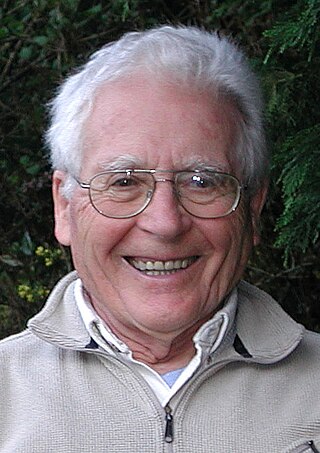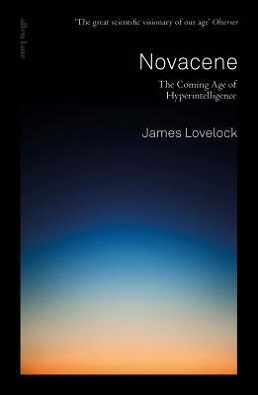
Astrobiology is a scientific field within the life and environmental sciences that studies the origins, early evolution, distribution, and future of life in the universe by investigating its deterministic conditions and contingent events. As a discipline, astrobiology is founded on the premise that life may exist beyond Earth.

James Ephraim Lovelock was an English independent scientist, environmentalist and futurist. He is best known for proposing the Gaia hypothesis, which postulates that the Earth functions as a self-regulating system.

Lynn Margulis was an American evolutionary biologist, and was the primary modern proponent for the significance of symbiosis in evolution. Historian Jan Sapp has said that "Lynn Margulis's name is as synonymous with symbiosis as Charles Darwin's is with evolution." In particular, Margulis transformed and fundamentally framed current understanding of the evolution of cells with nuclei – an event Ernst Mayr called "perhaps the most important and dramatic event in the history of life" – by proposing it to have been the result of symbiotic mergers of bacteria. In 2002, Discover magazine recognized Margulis as one of the 50 most important women in science.

SimEarth: The Living Planet is a life simulation game, the second designed by Will Wright. and published in 1990 by Maxis. In SimEarth, the player controls the development of a planet. English scientist James Lovelock served as an advisor and his Gaia hypothesis of planet evolution was incorporated into the game. Versions were made for the Macintosh, Atari ST, Amiga, IBM PC, Super Nintendo Entertainment System, Sega CD, and TurboGrafx-16. It was re-released for the Wii Virtual Console. In 1996, several of Maxis' simulation games were re-released under the Maxis Collector Series with greater compatibility with Windows 95 and differing box art, including the addition of Classics beneath the title. SimEarth was re-released in 1997 under the Classics label.
The Earth immune system is a controversial proposal, claimed to be a consequence of the Gaia hypothesis. The Gaia hypothesis holds that the entire earth may be considered a single organism (Gaia). As a self-maintaining organism, Earth would have an immune system of some sort in order to maintain its health.

Daisyworld, a computer simulation, is a hypothetical world orbiting a star whose radiant energy is slowly increasing or decreasing. It is meant to mimic important elements of the Earth-Sun system. James Lovelock and Andrew Watson introduced it in a paper published in 1983 to illustrate the plausibility of the Gaia hypothesis. In the original 1983 version, Daisyworld is seeded with two varieties of daisy as its only life forms: black daisies and white daisies. White petaled daisies reflect light, while black petaled daisies absorb light. The simulation tracks the two daisy populations and the surface temperature of Daisyworld as the sun's rays grow more powerful. The surface temperature of Daisyworld remains almost constant over a broad range of solar output.

A superorganism, or supraorganism, is a group of synergetically-interacting organisms of the same species. A community of synergetically-interacting organisms of different species is called a holobiont.

The Gaia hypothesis, also known as the Gaia theory, Gaia paradigm, or the Gaia principle, proposes that living organisms interact with their inorganic surroundings on Earth to form a synergistic and self-regulating, complex system that helps to maintain and perpetuate the conditions for life on the planet.

The natural environment or natural world encompasses all living and non-living things occurring naturally, meaning in this case not artificial. The term is most often applied to Earth or some parts of Earth. This environment encompasses the interaction of all living species, climate, weather and natural resources that affect human survival and economic activity. The concept of the natural environment can be distinguished as components:

Biogeochemistry is the scientific discipline that involves the study of the chemical, physical, geological, and biological processes and reactions that govern the composition of the natural environment. In particular, biogeochemistry is the study of biogeochemical cycles, the cycles of chemical elements such as carbon and nitrogen, and their interactions with and incorporation into living things transported through earth scale biological systems in space and time. The field focuses on chemical cycles which are either driven by or influence biological activity. Particular emphasis is placed on the study of carbon, nitrogen, oxygen, sulfur, iron, and phosphorus cycles. Biogeochemistry is a systems science closely related to systems ecology.

Gaianism is an earth-centered philosophical, holistic, and spiritual belief that shares expressions with earth religions and paganism while not identifying exclusively with any specific one. The term describes a philosophy and ethical worldview which, though not necessarily religious, implies a transpersonal devotion to earth as a superorganism. Practitioners of Gaianism are called Gaians.
Homeorhesis, derived from the Greek for "similar flow", is a concept encompassing dynamical systems which return to a trajectory, as opposed to systems which return to a particular state, which is termed homeostasis.

Planetary habitability is the measure of a planet's or a natural satellite's potential to develop and maintain environments hospitable to life. Life may be generated directly on a planet or satellite endogenously or be transferred to it from another body, through a hypothetical process known as panspermia. Environments do not need to contain life to be considered habitable nor are accepted habitable zones (HZ) the only areas in which life might arise.

Tyler Volk is Professor Emeritus of Environmental Studies and Biology at New York University.
The following outline is provided as a topical overview of science; the discipline of science is defined as both the systematic effort of acquiring knowledge through observation, experimentation and reasoning, and the body of knowledge thus acquired, the word "science" derives from the Latin word scientia meaning knowledge. A practitioner of science is called a "scientist". Modern science respects objective logical reasoning, and follows a set of core procedures or rules to determine the nature and underlying natural laws of all things, with a scope encompassing the entire universe. These procedures, or rules, are known as the scientific method.
The branches of science, also referred to as sciences, scientific fields or scientific disciplines, are commonly divided into three major groups:
Andrew James Watson FRS is a British marine and atmospheric scientist and an expert in processes affecting atmospheric carbon dioxide and oxygen concentrations. He was formerly a Professor of biogeochemistry in the School of Environmental Sciences at the University of East Anglia, in 2013 he moved to a position as Professor at the College of Life and Environmental Sciences at the University of Exeter.
Living systems are life forms treated as a system. They are said to be open self-organizing and said to interact with their environment. These systems are maintained by flows of information, energy and matter. Multiple theories of living systems have been proposed. Such theories attempt to map general principles for how all living systems work.
The balance of nature, also known as ecological balance, is a theory that proposes that ecological systems are usually in a stable equilibrium or homeostasis, which is to say that a small change will be corrected by some negative feedback that will bring the parameter back to its original "point of balance" with the rest of the system. The balance is sometimes depicted as easily disturbed and delicate, while other times it is inversely portrayed as powerful enough to correct any imbalances by itself. The concept has been described as "normative", as well as teleological, as it makes a claim about how nature should be: nature is balanced because "it is supposed to be balanced". The theory has been employed to describe how populations depend on each other, for example in predator-prey systems, or relationships between herbivores and their food source. It is also sometimes applied to the relationship between the Earth's ecosystem, the composition of the atmosphere, and weather.

Novacene: The Coming Age of Hyperintelligence is a 2019 non-fiction book by scientist and environmentalist James Lovelock. It has been published by Penguin Books/Allen Lane in the UK, and republished by the MIT Press. The book was co-authored by journalist Bryan Appleyard. It predicts that a benevolent eco-friendly artificial superintelligence will someday become the dominant lifeform on the planet and argues humanity is on the brink of a new era: the Novacene.












